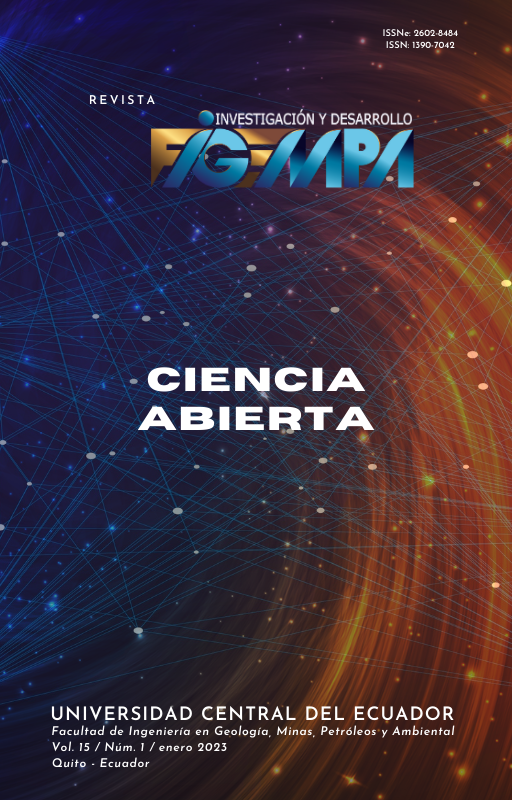PP GIS as an alternative for data collection for territorial planning in Cuenca Ecuador
Main Article Content
Abstract
Today, information, knowledge and means of communication are increasingly available and growing at an accelerated rate. But exclusion from the media, information and specialized knowledge limits the participation of the population. The New Information and Communication Technologies (NICT) are presented as a tool that facilitates interconnection through mechanisms according to time and space, allowing the improvement of social, political and public relations between subjects. NICTs allow the population to be involved in the processes, promoting the commitment of citizens in decision-making and therefore favor representative democracy, consolidating the so-called Cyber-Democracy. Web technology has proven to be a very useful tool for giving public access to information and relevant data that until now were only available to certain privileged sectors of the population. As a new tool, the implementation of GIS products on the Internet is proposed, such as the Geographic Information Systems of Public Participation (PP GIS), which provide an efficient and low-cost means for the collection, creation and distribution of cartographic products to users and strengthen citizen participation processes. In Cuenca-Ecuador, NICTs are scarcely used within the processes of citizen participation in territorial planning, so it is necessary to test their use as an alternative that improves the creation, updating and distribution of cartography. This work investigates the incorporation of a SIG PP in the territorial planning of the cantonal GAD of Cuenca indicating its advantages and disadvantages.
Downloads
Metrics
Article Details

This work is licensed under a Creative Commons Attribution 4.0 International License.
References
Bugs, G., Granell, C., Fonts, O., Huerta, J. & Painho, M. (2010) An assessment of Public Participation GIS and Web 2.0 technologies in urban planning practice in Canela, Brazil. Cities, 27(3), 172–181. https://doi.org/10.1016/j.cities.2009.11.008
Crecente, M. R., Santé, I., Sánchez, J., Reyes, F., & Delgado, O. (2014) Información, TIG, participación, metodologías y herramientas: Sixot una propuesta de integración. Recuperado a partir de http://www.sndu.org/ponencias/mesa3/R_Crecente-Otros.pdf
Estevez, E. & Janowski, T. (2014) Entrevista con Elsa Estevez y Tomasz Janowski, Centro para la Gobernanza Electrónica de la Universidad de las Naciones Unidas; Macao, China [Interview]. https://bit.ly/3gIMjXB
Geoportal web. (2022) http://ide.cuenca.gob.ec/geoportal-web/viewer.jsf
Ghaemi, P., Swift, J., Sister, C., Wilson, J. P. & Wolch, J. (2009) Design and implementation of a web-based platform to support interactive environmental planning. Computers, Environment and Urban Systems, 33(6), 482–491. https://doi.org/10.1016/j.compenvurbsys.2009.05.002
Han, S. S. & Peng, Z. (2003) Public Participation GIS (PPGIS) for Town Council Management in Singapore. Environment and Planning B: Planning and Design, 30(1), 89–111. https://doi.org/10.1068/b12938
INEC. (2010) Censo de población y vivienda 2010. Redatam: ECLAC/CELADE - R+SP WebServer.http://redatam.inec.gob.ec/cgibin/RpWebEngine.exe/PortalAction?&MODE=MAIN&BASE=CPV2010&MAIN=WebServerMain.inl
Kingston, R., Carver, S., Evans, A., Turton, I. (2000) Web-based public participation geographical information systems: an aid to local environmental decision making. Computers, Environment and Urban Systems, 24, 109-125
Maldonado Peralta, G. S. & Orellana Cuzco, D. E. (2021) El uso de los sistemas de información geográfica de participación pública: Una propuesta para su incorporación en la planificación territorial. Caso de estudio ciudad de Cuenca. http://dspace.ucuenca.edu.ec/handle/123456789/36319
Pacurucu Cáceres, N., & Morocho, V. (2020) Los PP GIS como geo-herramienta para el mapeo de zonas vulnerables, en el contexto de la planificación territorial: una revisión bibliográfica. Revista Geoespacial, 14(2), 116–125. Recuperado a partir de https://journal.espe.edu.ec/ojs/index.php/revista-geoespacial/article/view/1608
Rao, M., Fan, G., Thomas, J., Cherian, G., Chudiwale, V. & Awawdeh, M. (2007) A web-based GIS Decision Support System for managing and planning USDA’s Conservation Reserve Program (CRP). Environmental Modelling and Software, 22(9), 1270–1280. https://doi.org/10.1016/j.envsoft.2006.08.003
Sikder, I. & Gangopadhyay, A. (2002) Design and Implementation of a Web-Based Collaborative Spatial Decision Support System. IRMJ, 15, 33–47. https://doi.org/10.4018/irmj.2002100103
Tripathi, N. & Bhattarya, S. (2004) Integrating Indigenous Knowledge and GIS for Participatory Natural Resource Management: State of the Practice. The Electronic Journal of Information Systems in Developing Countries, 17(0) http://ejisdc.org/ojs2/index.php/ejisdc/article/view/105
Yaakup, A., Jama’an, J., Bakar, Y. A. y Sulaiman, S. (2001) Web-based GIS for public participation in urban planning and management. En: ASIA GIS, June, 20-22. Tokyo, Japón.
Zambrano, R. (2011) Nuevas tecnologías y gobernabilidad democrática: ¿Hacia una participación más inclusiva? In Tecnología y participación ciudadana en la construcción democrática. Instituto Electoral y de Participación Ciudadana de Jalisco.

